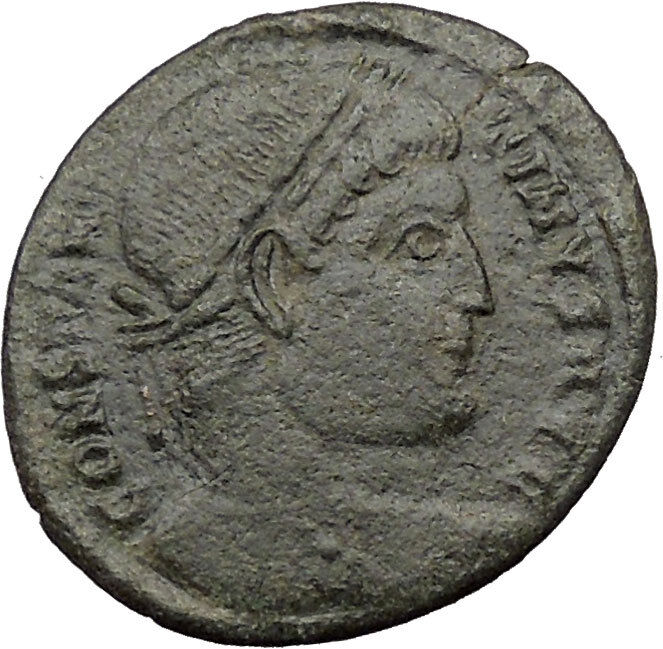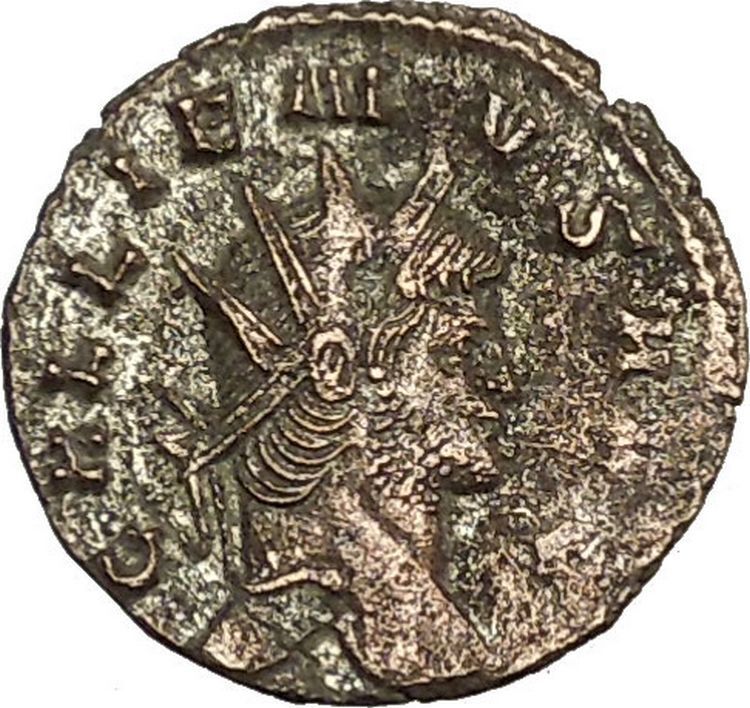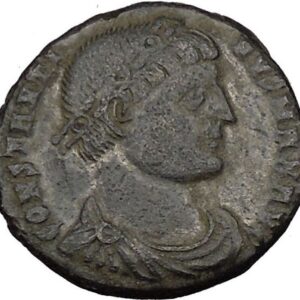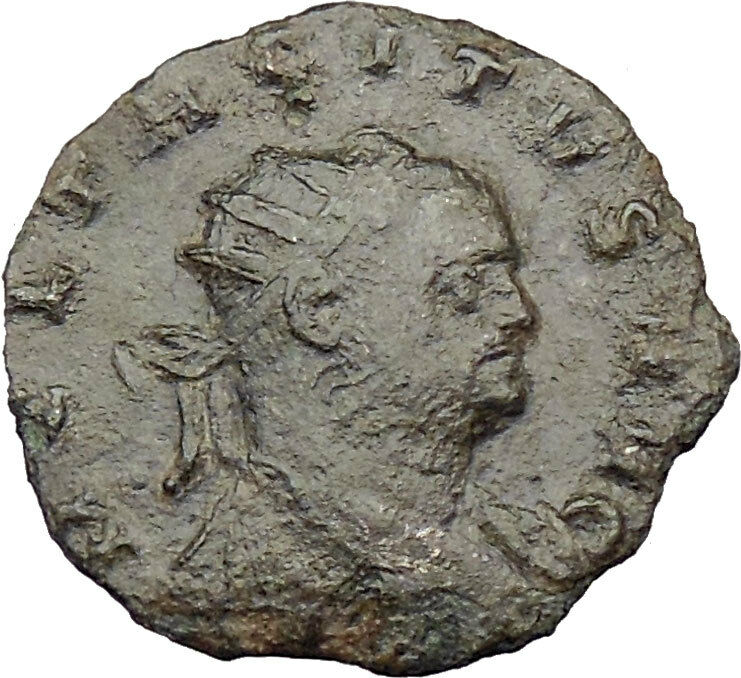|
Faustina
I – Roman Empress Wife of Roman Emperor
Antoninus Pius
Bronze Dupondius 27mm (9.84 grams) Struck under Antoninus Pius, Rome mint,
circa 146-161 A.D.
Reference: RIC 1163a (Antoninus Pius), C 38 As Obv:
DIVAAVGVSTAFAVSTINA – Diademed, draped bust right.
AETERNITAS – Providentia standing left, holding globe and scepter.
You are bidding on the exact item pictured,
provided with a Certificate of Authenticity and Lifetime Guarantee of
Authenticity.
In
Roman mythology
, Providentia was the
goddess
of forethought. Providentia.
(Providence).—-With all their vices, follies, and gross superstitions (indeed,
in spite of them), the Romans still appear to have cherished a belief in the
perpetual and direct interposition of the gods with respect to human
affairs.—-Among the various monuments which attest this religious feeling, or
at leas this profession of religion, on the part of both princes and people,
none are more conspicuous than those to be found on their imperial coins,
for it is to be observed that previous to the substitution of the monarchical
for the republican form of government, that allegorical divinity whose name is
derived from providere (to foresee) is not seen either on metal or on
marble.In
ancient Roman religion
, Providentia is a
divine personification of the ability to foresee and make provision. She was
among the embodiments of
virtues
that were part of the
Imperial cult of ancient Rome
.Providentia thus
figures in art
, cult, and
literature
, but has little or no
mythology
as such.
Providentia was an important moral and philosophical abstraction in
Roman discourse. Cicero
says it is one of the three main
components of prudentia, “the knowledge of things that are good or bad or
neither,” along with memoria, “memory,” and intellegentia,
“understanding.” The Latin word is the origin of the Christian concept of
divine providence
.
Imperial cult
Upon the death of
Augustus
, the emperor
Tiberius
established an
altar
to Providentia Augusta in recognition of
“the godhead manifested in his father’s provisions for the
Roman state
.” The cult title
Augusta
was attached also to such goddesses as
Pax
,
Justitia
, and
Concordia
during the
Imperial era
. Traditional epithets invoked a
deity within a specific functional sphere by declaring their power. The title
Augusta thus fixed the divinity’s force within the sphere of the emperor as
Augustus.
In 28 AD, after Tiberius arrested and executed
Sejanus
for conspiracy, the Cult of Virtues
played a role in the propaganda that presented the restoration of Imperial order
as a return to constitutional government. Sacrifices were offered to Providentia
along with Salus (“Security”),
Libertas
(“Liberty”), and the
Genius
. Providentia at this time also received
a permanent full-time priest (sacerdos)
devoted to her. In the wake of the
Pisonian conspiracy
against
Nero, religious observances in 59 AD to repair the state included
sacrifices by the
Arval Brethren
to various deities, among them
Providentia.
Providentia appeared on
Roman coins
issued under
Vespasian
,
Trajan
,
Hadrian
,
Antoninus Pius
,
Septimius Severus
,
Commodus
and
Diocletian
. A coin issued by
Titus
depicted his deified father Vespasian
handing a globe to his son as his successor, with the legend Providentia
Augusta. Coins issued by
Nerva
depicted the Genius of the
Senate
handing the globe to the new emperor,
with the legend Providentia Senatus, “the Providence of the Senate.”
Providentia in
numismatics

The figure of Providentia from a sculpture group in Vienna, as
depicted on an Austrian 100-euro gold coin
Providentia has been the main motif for many collector coins and medals, the
most recent one is the famous
100 euro Sculpture Gold coin
issued on November
13, 2002. The reverse features the Providentia Fountain (“Provendentia Brunnen”)
in central Vienna, work of one of the greatest baroque sculptor
Georg Rafael Donner
. In the centre of the coin,
the allegorical figure of Providentia with a medallion of the Roman god,
Janus
, who had two faces, is displayed.
Surrounding the fountain there are other symbolic figures representing tributary
rivers of the Danube
. Providentia is enthroned high above the
figure of an old man representing the
Enns River
.
Annia
Galeria Faustina, more familiarly referred to as Faustina the Elder (Latin:
Faustina Major; born
September 21
about 100, died October or November 140), was
 a Roman Empress and wife of a Roman Empress and wife of
Roman
Emperor
Antoninus Pius
.
Faustina was the only known daughter of consul and prefect
Marcus Annius Verus
and
Rupilia
Faustina. Her brothers were consul
Marcus Annius Libo
and
praetor
Marcus Annius Verus
. Her maternal aunts perhaps were Roman Empress
Vibia
Sabina
,
Matidia Minor
. Her paternal grandfather had the same name as her father and
her maternal grandparents possibly were
Salonina Matidia
(niece of Roman Emperor
Trajan
) and
suffect consul
Lucius Scribonius Libo Rupilius Frugi Bonus
. Faustina was born and raised in
Rome.
As a private citizen, she married Antoninus Pius between 110
and 115. Faustina and Antoninus had a very happy marriage. Faustina bore
Antoninus four children, two sons and two daughters. They were:
-
Marcus Aurelius Fulvius Antoninus (died before 138); his
sepulchral inscription has been found at the Mausoleum of Hadrian in Rome.
-
Marcus Galerius Aurelius Antoninus (died before 138); his
sepulchral inscription has been found at the Mausoleum of Hadrian in Rome.
His name appears on a Greek Imperial coin.
-
Aurelia Fadilla (died in 135); she married Aelius Lamia
Silvanus or Syllanus. She appears to have had no children with her husband
and her sepulchral inscription has been found in
Italy
.
-
Annia Galeria Faustina Minor or
Faustina the Younger
(between 125-130-175), a future Roman Empress; she
married her maternal cousin, future Roman Emperor
Marcus Aurelius
. She was the only child who survived to adulthood.
On
July 10
,
138, her uncle
emperor Hadrian
had died and her husband became the new emperor. Antoninus was Hadrian’s adopted
son and heir. Faustina became Roman Empress and the senate accorded her the
title of
Augusta
. Faustina as an empress was well respected and this beautiful
woman was renowned for her wisdom. The
Augustan History
impugned her character, criticizing her as having
“excessive frankness” and “levity”. However, this doesn’t appear to be the case
with her character. Throughout her life, Faustina as a private citizen and an
empress was involved in assisting with charities, assisting the poor and
sponsoring and assisting in the education of Roman children, particularly of
Roman girls.
She can be viewed as one of the most moral, stable and
respected empresses in the history of the
Roman
Empire
. When Faustina died, Antoninus was in complete mourning for Faustina.
Antoninus did the following in memory of his loving wife:
-
Deified her
as a goddess (her apotheosis was portrayed on an
honorary column
)
-
Had
a temple
built in the
Roman
Forum
in her name, with priestesses in the temple.
-
Had various coins with her portrait struck in her honor.
These coins were inscribed DIVA FAVSTINA (“Divine Faustina”)
and were elaborately decorated.
-
Founded a charity called Puellae Faustinianae or
Girls of Faustina, which assisted orphaned girls.
-
Created a new alimenta (see
Grain supply to the city of Rome
).
In 2008, archaeologists digging at the ancient site of
Sagalassos
in Turkey
discovered a colossal marble head which is believed to be that of Faustina.
The Principate
Julio-Claudian
dynasty
|
Reign
|
Incumbent
|
Notes
|
|
16 January 27 BC to 19 August AD 14
|
Augustus
|
|
|
19 August 14 to 16 March 37
|
Tiberius
|
|
|
18 March 37 to 24 January 41
|
Caligula
|
Murdered by Praetorian Guard
|
|
24 January 41 to 13 October 54
|
Claudius
|
Poisoned by his wife Agrippina, mother of Nero
|
|
13 October 54 to 11 June 68
|
Nero
|
Made a slave kill him
|
Year
of the Four Emperors (Civil War)
|
Reign
|
Incumbent
|
Notes
|
|
8 June 68 to 15 January 69
|
Galba
|
Murdered in favour of
Otho
|
|
15 January 69 to 16 April 69
|
Otho
|
Committed suicide
|
|
2 January 69 to 20 December 69
|
Vitellius
|
Murdered in favour of
Vespasian
|
Flavian
dynasty
|
Reign
|
Incumbent
|
Notes
|
|
1 July 69 to 24 June 79
|
Vespasian
|
|
|
24 June 79 to 13 September 81
|
Titus
|
Possibly assassinated by Domitian
|
|
14 September 81 to 18 September 96
|
Domitian
|
Assassinated
|
Nervan-Antonian
dynasty
Main article:
Five Good Emperors
|
Reign
|
Incumbent
|
Notes
|
|
18 September 96 to 27 January 98
|
Nerva
|
Proclaimed emperor by senate
|
|
28 January 98 to 7 August 117
|
Trajan
|
|
|
11 August 117 to 10 July 138
|
Hadrian
|
|
|
10 July 138 to 7 March 161
|
Antoninus Pius
|
|
|
7 March 161 to 17 March 180
|
Marcus Aurelius
|
|
|
7 March 161 to March 169
|
Lucius Verus
|
Co-emperor with
Marcus Aurelius
|
|
175
|
Avidius Cassius
|
Usurper; ruled in Egypt and Syria; murdered by his own army
|
|
177 to 31 December 192
|
Commodus
|
Assassinated
|
Year
of the Five Emperors &
Severan dynasty
|
Reign
|
Incumbent
|
Notes
|
|
1 January 193 to 28 March 193
|
Pertinax
|
Proclaimed emperor by senate; murdered by Praetorian Guard
|
|
28 March 193 to 1 June 193
|
Didius Julianus
|
Proclaimed emperor by Praetorian Guard; executed on orders of the Senate
|
|
9 April 193 to 4 February 211
|
Septimius Severus
|
Proclaimed emperor by
Pannonian
troops; accepted by
senate
|
|
193 to 194/195
|
Pescennius Niger
|
Proclaimed emperor by Syrian troops, defeated in battle by
Septimius Severus
|
|
193/195 to 197
|
Clodius Albinus
|
Proclaimed emperor by British troops, defeated in battle by
Septimius Severus
|
|
198 to 8 April 217
|
Caracalla
|
Assassinated at the behest of
Macrinus
|
|
209 to 4 February 211
|
Geta
|
Co-emperor with
Caracalla
; assassinated on orders
of
Caracalla
|
|
11 April 217 to June 218
|
Macrinus
|
Proclaimed himself emperor; executed on orders of
Elagabalus
|
|
May 217 to June 218
|
Diadumenian
|
Junior co-emperor under
Macrinus
; executed
|
|
June 218 to 222
|
Elagabalus
|
Proclaimed emperor by army; murdered by his own troops
|
|
13 March 222 to ?March 235
|
Alexander Severus
|
Murdered by his own troops
|
Rulers during the
Crisis of the Third Century
|
Reign
|
Incumbent
|
Notes
|
|
February/March 235 to March/April 238
|
Maximinus Thrax
|
Proclaimed emperor by the army; murdered by
Praetorian Guard
|
|
earlyJanuary/March
238 to lateJanuary/April 238
|
Gordian I
|
Proclaimed emperor in Africa; committed suicide after
Gordian II
‘s death
|
|
earlyJanuary
March 238 to lateJanuary/April 238
|
Gordian II
|
Proclaimed emperor with
Gordian I
, killed in battle
|
|
earlyFebruary
238 to earlyMay 238
|
Pupienus
|
Proclaimed joint emperor by senate; murdered by
Praetorian Guard
|
|
earlyFebruary
238 to earlyMay 238
|
Balbinus
|
Proclaimed joint emperor by senate; murdered by
Praetorian Guard
|
|
May 238 to February 244
|
Gordian III
|
Nephew of
Gordian II
; death unclear,
probably murdered
|
|
240
|
Sabinianus
|
Usurper; proclaimed himself emperor; defeated in battle
|
|
February 244 to September/October 249
|
Philip the Arab
|
Proclaimed emperor after death of
Gordian III
; killed in battle by
Decius
|
|
248
|
Pacatianus
|
Usurper; proclaimed himself emperor; murdered by his own soldiers
|
|
248 to 249
|
Iotapianus
|
Usurper; proclaimed himself emperor in the east; murdered by his own
soldiers
|
|
248? or 253?
|
Silbannacus
|
Usurper; details essentially unknown
|
|
249 to June 251
|
Decius
|
Killed in battle
|
|
249 to 252
|
Priscus
|
Proclaimed himself emperor in the east in opposition to
Decius
|
|
250 to 250
|
Licinianus
|
Usurper; proclaimed emperor in Rome; rebellion suppressed
|
|
early251
to June 251
|
Herennius Etruscus
|
Junior co-emperor under
Decius
; killed in battle
|
|
251
|
Hostilian
|
Son of
Decius
; died of plague
|
|
June 251 to August 253
|
Gallus
|
Proclaimed emperor by his troops after Decius’s death; murdered by them
in favour of Aemilianus
|
|
July 251 to August 253
|
Volusianus
|
Junior co-emperor under
Gallus
; murdered by army
|
|
August 253 to October 253
|
Aemilian
|
Proclaimed emperor by his troops; murdered by them in favour of
Valerian
|
|
253 to June 260
|
Valerian
|
Proclaimed emperor by his troops; captured in battle by the
Persians
; died in captivity
|
|
253 to September 268
|
Gallienus
|
Junior co-emperor under
Valerian
to 260; probably murdered
by his generals
|
|
260
|
Saloninus
|
Son of
Gallienus
; proclaimed emperor by
army; murdered shortly after by troops of
Postumus
|
|
June 260 (or 258)
|
Ingenuus
|
Usurper; proclaimed himself emperor after
Valerian
‘s capture; defeated in
battle
|
|
260
|
Regalianus
|
Usurper; proclaimed emperor after
Ingenuus
‘s defeat; fate unclear
|
|
260 to 261
|
Macrianus Major
|
Usurper; proclaimed emperor by eastern army; defeated and killed in
battle
|
|
260 to 261
|
Macrianus Minor
|
Usurper; son of
Macrianus Major
; defeated and
killed in battle
|
|
260 to 261
|
Quietus
|
Usurper; son of
Macrianus Major
; defeated and
killed in battle
|
|
261 to 261 or 262
|
Mussius Aemilianus
|
Usurper; proclaimed himself emperor after the defeat of the Macriani;
defeated and executed
|
|
268 to 268
|
Aureolus
|
Usurper; proclaimed himself emperor after
Gallienus
‘s death; surrendered to
Claudius II Gothicus
; murdered by
Praetorian Guard
|
|
268 to August 270
|
Claudius II Gothicus
|
Proclaimed emperor by the army
|
|
August 270 to September 270
|
Quintillus
|
Proclaimed himself emperor; cause of death unclear
|
|
August 270 to 275
|
Aurelian
|
Proclaimed emperor by army; murdered by the
Praetorian Guard
|
|
271 to 271
|
Septimius
|
Usurper; proclaimed emperor in
Dalmatia
; killed by his own
soldiers
|
|
November/December 275 to July 276
|
Tacitus
|
Appointed emperor by the Senate; possibly assassinated
|
|
July 276 to September 276
|
Florianus
|
Brother of
Tacitus
, proclaimed emperor by the
western army; murdered by his troops
|
|
July 276 to lateSeptember 282
|
Probus
|
Proclaimed emperor by the eastern army; murdered by his own soldiers in
favour of
Carus
|
|
280
|
Julius Saturninus
|
Usurper; proclaimed emperor by his troops; then killed by them
|
|
280
|
Proculus
|
Usurper; proclaimed himself emperor at the request of the people of
Lugdunum
; executed by
Probus
|
|
280
|
Bonosus
|
Usurper; proclaimed himself emperor; defeated by
Probus
and committed suicide
|
|
September 282 to July/August 283
|
Carus
|
Proclaimed emperor by Praetorian guard
|
|
spring 283 to summer 285
|
Carinus
|
Son of Carus; co-emperor with
Numerian
; fate unclear
|
|
July/August 283 to November 284
|
Numerian
|
Son of Carus; co-emperor with
Carinus
; probably murdered
|
Gallic
Empire
260
to 274
|
Reign
|
Incumbent
|
Notes
|
|
260 to 268
|
Postumus
|
Declared himself emperor after
Valerian
‘s death; killed by his
own troops
|
|
268 to 268
|
Laelianus
|
Proclaimed himself emperor in opposition to Postumus; defeated and
killed by Postumus
|
|
269 to 269
|
Marius
|
Proclaimed himself emperor after Postumus’s death
|
|
269 to 271
|
Victorinus
|
Proclaimed emperor after Marius’s death
|
|
270 to 271
|
Domitianus
|
Proclaimed himself emperor of the
Gallic Empire
|
|
271 to 274
|
Tetricus I
|
Nominated heir to Victorinus
|
Britannic
Empire
286
to 297
|
Reign
|
Incumbent
|
Notes
|
|
286 to 293
|
Carausius
|
Declared himself emperor; assassinated by
Allectus
|
|
293 to 297
|
Allectus
|
Declared himself emperor after
Carausius
‘s death; defeated by
Constantius Chlorus
|
Dominate
Tetrarchy
and
Constantinian dynasty
|
Reign
|
Incumbent
|
Notes
|
|
20 November 284 to 1 May 305
|
Diocletian
|
Declared emperor by the army after Numerian’s death; Abdicated
|
|
1 April 286 to 1 May 305
|
Maximian
|
Made co-emperor (‘Augustus’) with
Diocletian
; abdicated
|
|
1 May 305 to 25 July 306
|
Constantius I Chlorus
|
Made junior co-emperor (‘Caesar’) under
Maximian
; became Augustus after
his abdication
|
|
1 May 305 to May 311
|
Galerius
|
Made junior co-emperor (‘Caesar’) under
Diocletian
; became Augustus after
his abdication
|
|
August 306 to 16 September 307
|
Severus II
|
Made junior co-emperor (‘Caesar’) under
Constantius Chlorus
; became
Augustus after his death; executed by
Maxentius
|
|
28 October 306 to 28 October 312
|
Maxentius
|
Son of
Maximian
; proclaimed Augustus by
Praetorian Guard
; defeated in
battle by
Constantine I
|
|
de jure:
307, de facto 312 to 22 May 337
|
Constantine I
|
Son of
Constantius Chlorus
; proclaimed
Augustus by army
|
|
308
–309?/311?
|
Domitius Alexander
|
Proclaimed emperor in Africa; defeated in battle by
Maxentius
|
|
11 November 308 to 18 September 324
|
Licinius
|
Appointed Augustus by
Galerius
; deposed by
Constantine I
and executed
|
|
1 May 311 to July/August 313
|
Maximinus Daia
|
Made junior co-emperor (‘Caesar’) under
Galerius
; became Augustus after
his death; defeated in battle by Licinius and committed suicide
|
|
December 316 to 1 March 317
|
Valerius Valens
|
Appointed co-Augustus by
Licinius
; executed by
Licinius
|
|
July to 18 September 324
|
Martinianus
|
Appointed co-Augustus by
Licinius
; deposed by
Constantine I
and executed
|
|
337 to 340
|
Constantine II
|
Son of
Constantine I
; co-emperor with his
brothers; killed in battle
|
|
337 to 361
|
Constantius II
|
Son of
Constantine I
; co-emperor with his
brothers
|
|
337 to 350
|
Constans I
|
Son of
Constantine I
; co-emperor with his
brothers, killed by
Magnentius
|
|
January 350 to 11 August 353
|
Magnentius
|
Usurper; proclaimed emperor by the army; defeated by
Constantius II
and committed
suicide
|
|
c.
350
|
Vetranio
|
Proclaimed himself emperor against
Magnentius
; recognized by
Constantius II
but then deposed
|
|
c.
350
|
Nepotianus
|
Proclaimed himself emperor against
Magnentius
, defeated and executed
by
Magnentius
|
|
November 361 to June 363
|
Julian
|
Cousin of
Constantius II
; made Caesar by
Constantius, then proclaimed Augustus by the army; killed in battle
|
|
363 to 17 February 364
|
Jovian
|
Proclaimed emperor by the army after
Julian
‘s death
|
Valentinian
dynasty
|
Reign
|
Incumbent
|
Notes
|
|
26 February 364 to 17 November 375
|
Valentinian I
Valentinian I Coins.htm
|
Proclaimed emperor by the army after
Jovian
‘s death
|
|
28 March 365 to 9 August 378
|
Valens
|
Made co-emperor in the east by his brother
Valentinian I
; killed in battle
|
|
September 365 to 27 May 366
|
Procopius
|
Usurper; Proclaimed himself emperor; defeated and executed by
Valens
|
|
24 August 367 to 383
|
Gratian
Gratian Coins.htm
|
Son of
Valentinian I
; assassinated
|
|
375 to 392
|
Valentinian II
Valentinian II Coins.htm
|
Son of
Valentinian I
; deposed by
Arbogast
and died in suspicious
circumstances
|
|
383 to 388
|
Magnus Maximus
Magnus Maximus Coins.htm
|
Usurper; proclaimed emperor by troops; at one time recognized by
Theodosius I
, but then deposed and
executed
|
|
c.386
to 388
|
Flavius Victor
Flavius Victor Coins.htm
|
Son of Magnus Maximus, executed on orders of
Theodosius I
|
|
392 to 394
|
Eugenius
Eugenius Coins.htm
|
Usurper; proclaimed emperor by army under
Arbogast
; defeated in battle by
Theodosius I
|
Theodosian
dynasty
|
Reign
|
Incumbent
|
Notes
|
|
379 to 17 January 395
|
Theodosius I
Theodosius I Coins.htm
|
Made co-emperor for the east by
Gratian
|
|
383 to 408
EAST
|
Arcadius
Arcadius Coins.htm
|
Appointed co-emperor with his father
Theodosius I
; sole emperor for the
east from January 395
|
|
23 January 393 to 15 August 423
WEST
|
Honorius
Honorius Coins.htm
|
Appointed Augustus for the west by his father
Theodosius I
|
|
407 to 411
WEST
|
Constantine III
Constantine III Coins.htm
|
Usurper; proclaimed emperor in Britain; defeated by
Constantius III
|
|
409 to 411
WEST
|
Constans II
Constans II Coins.htm
|
Usurper; made emperor by his father
Constantine III
; killed in battle
|
|
409 and 414 to 415
WEST
|
Priscus Attalus
Priscus Attalus Coins.htm
|
Usurper; twice proclaimed emperor by
Visigoths
under
Alaric
and twice deposed by
Honorius
|
|
409 to 411
WEST
|
Maximus
Maximus Coins.htm
|
Usurper; proclaimed emperor in Spain; abdicated
|
|
411 to 413
WEST
|
Jovinus
Jovinus Coins.htm
|
Usurper; proclaimed emperor after
Constantine III
‘s death, executed
by
Honorius
|
|
412 to 413
WEST
|
Sebastianus
Sebastianus Coins.htm
|
Usurper; appointed co-emperor by
Jovinus
, executed by
Honorius
|
|
408 to 450
EAST
|
Theodosius II
Theodosius II Coins.htm
|
Son of
Arcadius
|
|
421 to 421
WEST
|
Constantius III
Constantius III Coins.htm
|
Son-in-law of
Theodosius I
; appointed co-emperor
by
Honorius
|
|
423 to 425
WEST
|
Joannes
Johannes Coins.htm
|
Proclaimed western emperor, initially undisputed; defeated and executed
by
Theodosius II
in favour of
Valentinian III
|
|
425 to 16 March 455
WEST
|
Valentinian III
Valentinian III Coins.htm
|
Son of
Constantius III
; appointed emperor
by
Theodosius II
; assassinated
|
Western
Roman Empire
|
Reign
|
Incumbent
|
Notes
|
|
17 March 455 to 31 May 455
|
Petronius Maximus
Petronius Maximus Coins.htm
|
Proclaimed himself emperor after
Valentinian III
‘s death; murdered
|
|
June 455 to 17 October 456
|
Avitus
Avitus Coins.htm
|
Proclaimed emperor by the
Visigoth
king
Theoderic II
; deposed by
Ricimer
|
|
457 to 2 August 461
|
Majorian
Majorian Coins.htm
|
Appointed by
Ricimer
; deposed and executed by
Ricimer
|
|
461 to 465
|
Libius Severus
Libius Severus Coins.htm
|
Appointed by
Ricimer
; deposed and executed by
Ricimer
|
|
12 April 467 to 11 July 472
|
Anthemius
Anthemius Coins.htm
|
Appointed by
Ricimer
; deposed and executed by
Ricimer
|
|
July 472 to 2 November 472
|
Olybrius
Olybrius Coins.htm
|
Appointed by
Ricimer
|
|
5 March 473 to June 474
|
Glycerius
Glycerius Coins.htm
|
Appointed by
Gundobad
; deposed by
Julius Nepos
|
|
June 474 to 25 April 480
|
Julius Nepos
Julius Nepos Coins.htm
|
Appointed by eastern emperor
Leo I
; deposed in Italy by
Orestes
in 475; continued to be
recognised as lawful emperor in Gaul and Dalmatia until his murder in
480
|
|
31 October 475 to 4 September 476
|
Romulus Augustus
(Romulus
Augustulus)
Romulus Augustus Coins.htm
|
Son of
Orestes
; deposed by
Odoacer
; fate unknown
|
Further information:
Barbarian kings of Italy
Eastern
Roman Empire
-
For
the rulers of the Eastern Roman Empire (also known as the
Byzantine Empire
) after
Theodosius II
, see:
List of Byzantine Emperors
Theodosian dynasty (395–457)
See also:
Theodosian dynasty
| Name |
Reign |
Comments |
| |
Theodosius I “the Great”
(Θεοδόσιος Α’ ο Μέγας, Flavius Theodosius)Theodosius
I Coins.htm |
19 January 379 –
17 January 395 |
Born on 11 January 347. Aristocrat and military leader,
brother-in-law of Gratian, who appointed him as emperor of the East.
From 392 until his death sole Roman emperor |
| |
Arcadius
(Αρκάδιος, Flavius Arcadius)Arcadius
Coins.htm |
17 January 395 –
1 May 408 |
Born in 377/378, the eldest son of Theodosius I.
Succeeded upon the death of his father |
| |
Theodosius II
(Θεοδόσιος Β’, Flavius Theodosius)
Theodosius II Coins.htm |
1 May 408 –
28 July 450 |
Born on 10 April 401, the only son of Arcadius.
Succeeded upon the death of his father. As a minor, the praetorian
prefect
Anthemius
was regent in 408–414. He
died in a riding accident |

|
Marcian
(Μαρκιανός, Flavius Valerius Marcianus)
Marcian Coins.htm
|
450 – January 457 |
Born in 396. A soldier and
politician, he became emperor after being wed by the Augusta
Pulcheria
, Theodosius II’s sister,
following the latter’s death. Died of
gangrene
|
Leonid
dynasty (457–518)
See also:
House of Leo
| Name |
Reign |
Comments |
| |
Leo I “the Thracian”
(Λέων Α’ ο Θράξ, Flavius Valerius Leo)
Leo I Coins.htm
|
7 February 457 –
18 January 474 |
Born in
Dacia
in 401. A common soldier, he was
chosen by Aspar
, commander-in-chief of the army.
Died of dysentery |

|
Leo II
(Λέων Β’, Flavius Leo)
Leo II
Coins.htm
|
18 January –
17 November 474 |
Born in 467, the grandson of Leo I. Succeeded upon the
death of Leo I. Died of an unknown disease, possibly poisoned |

|
Zeno
(Ζήνων, Flavius Zeno)
Zeno Coins.htm
|
17 November 474 –
9 April 491 |
Born c.425 at
Zenonopolis
,
Isauria
, originally named
Tarasicodissa. Son-in-law of Leo I, he was bypassed in the succession
because of his barbarian origin. Named co-emperor by his son on 9
February 474, he succeeded upon the death of Leo II. Deposed by
Basiliscus, brother-in-law of Leo, he fled to his native country and
regained the throne in August 476. |

|
Basiliscus
(Βασιλίσκος, Flavius Basiliscus)
Basiliscus Coins.htm
|
9 January 475 –
August 476 |
General and brother-in-law of Leo I, he seized power
from Zeno but was again deposed by him. Died in 476/477 |

|
Anastasius I
(Αναστάσιος Α’, Flavius Anastasius)
BYZANTINE – Anastasius
Coins.htm
|
11 April 491 –
9 July 518 |
Born c. 430 at
Dyrrhachium
,
Epirus nova
. A palace official (silentiarius)
and son-in-law of Leo I, he was chosen as emperor by empress-dowager
Ariadne
|
Justinian Dynasty
Main article:
Justinian Dynasty
| Portrait |
Name |
Born |
Reigned |
Succession |
Died |

|
Justin I
FLAVIVS IVSTINVS AVGVSTVS |
c. 450 AD,
Naissus
|
July 9, 518 AD – August 1, 527 AD |
Commander of the palace guard under
Anastasius I)
; elected as emperor with
support of army |
August 1, 527 AD
Natural causes |
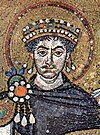
|
Justinian I
FLAVIVS PETRVS SABBATIVS IVSTINIANVS AVGVSTVS |
c. 482 AD,
Tauresium
,
Dardania
|
August 1, 527 AD – 13/14 November 565 AD |
Nephew and nominated heir of
Justin I
|
13/14 November 565 AD
Natural causes |

|
Justin II
FLAVIVS IVSTINIVS IVNIOR AVGVSTVS |
c. 520 AD, ? |
13/14 November 565 AD – 578 AD |
Nephew of
Justinian I
|
578 AD
Became insane;
Tiberius II Constantine
ruled as regent
from December 574 and became emperor on Justin’s death in 578 |
Roman Late Monogram Coins.htm
Roman AE4 Coins.htm
|











 a Roman Empress and wife of
a Roman Empress and wife of